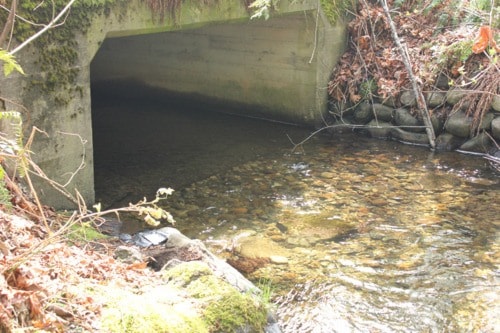Barry Budden says that for years he has been trying to get the Department of Fisheries and Oceans (DFO) to install a proper fish ladder in the culvert section of Beadnell creek that runs under South Shore Road. The baffles (structures that obstruct water flow) that are in place were installed approximately 30 years ago, and Budden says they are not working.
When the fish come upstream to spawn, Budden says they make several attempts to pass through the long section of culvert running under Shore Shore Road and beyond towards the Esso station before they tire out and are instead are swept back by current to spawn in the small section of the creek that drains into the Cowichan River.
Budden says that when DFO installed the existing baffles, “they drilled a hole, stuck a ready-rod in it and poured a bag of concrete on top.” The concrete became water logged and after about two years it washed away. This means that the fish no longer have anywhere to rest and escape the steady current of water as they make their way through the culvert in an attempt to get further upstream.
As far as Budden is concerned, a proper fish ladder baffle would consist of ready-rod and concrete structures placed at intervals on either side of the stream along the entire length of the culvert. He says that right now, the coho are starting to hatch and because they do not have the advantage of the protection that hatching further upstream would have given them, their chances for survival are lessened. So to help them out, he feeds them. He purchases food from the federal fisheries office in Duncan and feeds them from his property, which sits right next to the bottom part of the creek. “I hope to give them a better chance at avoiding predators,” he says.
Erica Blake, a community advisor for southern Vancouver Island with the DFO, says that a recent reconnaissance has shown that the existing baffles are still in place. “There might just have to be a little maintenance,” she says. She also acknowledged that past the culvert, further up the creek-bed is 80 per cent full of gravel.
Blake says that there is nothing imminently planned for the culvert or the creek, but that she is aware that the Cowichan Lake and River Stewardship Society, and the Cowichan Lake Salmonid Enhancement Society, are both interested in helping with projects such as this. She says the window for doing this kind of work exists between June 15 and Sept. 15 and that any upgrades or maintenance may or may not happen during that time. She is hoping there will be a meeting in the near future to consult with the Cowichan Lake and River Stewardship Society, the Cowichan Lake Salmonid Enhancement Society and First Nations representatives to discuss how much work has to be done.
